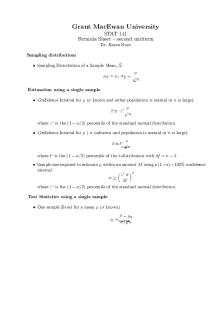Bloch Theorem - Lecture notes 2 PDF

| Title | Bloch Theorem - Lecture notes 2 |
|---|---|
| Author | Suraj Saw |
| Course | Physics |
| Institution | Kolhan University |
| Pages | 2 |
| File Size | 99.5 KB |
| File Type | |
| Total Downloads | 68 |
| Total Views | 133 |
Summary
Band theory of solids...
Description
Statement of Bloch theorem: Bloch theorem states that, the solutions of Schrödinger wave equation for an electron moving in a periodic potential are the plane waves modulated by a function having the same periodicity as that of the lattice. Explanation: For an electron moving in a one-dimensional periodic potential, 𝑉(𝑥), the Schrödinger equation is written as 𝑑2𝑦 2𝑚 + 2 [𝐸 − 𝑉(𝑥)] = 0-------------------------- (1) 2 𝑑𝑥
ℏ
𝑉(𝑥) = 𝑉(𝑥 + 𝑎) --------------------------- (2) and a is lattice constant. According to the Bloch theorem, the solution of the above equation must be of the form 𝜓(𝑥 ) = 𝑒 ±𝑖𝐾𝑥 𝑢𝐾 (𝑥 ) --------------------------- (3) Where 𝑢𝐾 (𝑥) = 𝑢𝐾 (𝑥 + 𝑎)------------------ (4) K=wave vector. 𝑢𝐾 is a function having complete periodicity of the lattice. The functions of the type of equation (3) are known as Block function ∙𝑟 For three dimensional case it is given as 𝜓(𝑟) = 𝑒 ±𝑖𝐾 𝑢𝐾 (𝑟) Proof:Let 𝑔(𝑥) and 𝑓(𝑥) be two real and independent solutions of the second order differential equation (1). So the general solution can be written as 𝜓(𝑥 ) = 𝐴 𝑓(𝑥 ) + 𝐵 𝑔(𝑥) ------------------ (5) Since 𝑉(𝑥) = 𝑉(𝑥 + 𝑎), the functions 𝑓(𝑥 + 𝑎) and 𝑔(𝑥 + 𝑎) must also be the solutions of equation (1). But only two independent solutions are possible for second order linear differential equation. So 𝑓(𝑥 + 𝑎) and 𝑔(𝑥 + 𝑎) must be expressed as a linear combination of 𝑓(𝑥) and 𝑔(𝑥) as 𝑓(𝑥 + 𝑎) = 𝛼1 𝑓(𝑥) + 𝛼2 𝑔(𝑥) ∙∙∙∙∙∙∙∙ (𝑎) } --- (6) 𝑔(𝑥 + 𝑎) = 𝛽1 𝑓(𝑥) + 𝛽2 𝑔(𝑥) ∙∙∙∙∙∙∙∙ (𝑏) Where 𝛼1 , 𝛼2 , 𝛽1 and 𝛽2 are the real functions of energy E. Now we may write another solution from equation (5) using equation (6) as 𝜓(𝑥 + 𝑎) = 𝐴 𝑓(𝑥 + 𝑎) + 𝐵 𝑔(𝑥 + 𝑎) = (𝐴𝛼1 + 𝐵𝛽1 )𝑓(𝑥) + (𝐴𝛼2 + 𝐵𝛽2 )𝑔(𝑥) --- (7) the property given in equation (6) we should choose 𝐴 and 𝐵 such that 𝐴𝛼1 + 𝐵𝛽1 = 𝜆𝐴 ∙∙∙∙∙∙∙∙ (𝑎) } ------ (8) 𝐴𝛼2 + 𝐵𝛽2 = 𝜆𝐵 ∙∙∙∙∙∙∙∙∙ (𝑏) Where 𝜆 is a constant. So equation (7) may be written as 𝜓(𝑥 + 𝑎) = 𝜆[𝐴𝑓(𝑥) + 𝐵𝑔(𝑥)] = 𝜆𝜓(𝑥) ----- (9) The equations (8) has non-zero values of 𝐴 and 𝐵 only if the determinant of their co-efficient vanish. 𝛽1 𝛼 −𝜆 |=0 So | 1 𝛼2 𝛽2 − 𝜆 ⇒ (𝛼1 − 𝜆)(𝛽2 − 𝜆) − 𝛼2 𝛽1 = 0 ⇒ 𝛼1 𝛽2 − (𝛼1 + 𝛽2 )𝜆 + 𝜆2 − 𝛼2 𝛽1 = 0 ---- (10) Taking first order derivative of equations (6) we get 𝑓′(𝑥 + 𝑎) = 𝛼1 𝑓′(𝑥) + 𝛼2 𝑔′(𝑥) 𝑔′(𝑥 + 𝑎) = 𝛽1 𝑓′(𝑥) + 𝛽2 𝑔′(𝑥) Now, 𝑓(𝑥 + 𝑎) 𝑔′(𝑥 + 𝑎) – 𝑔(𝑥 + 𝑎) 𝑓′(𝑥 + 𝑎) = [𝛼1 𝑓(𝑥) + 𝛼2 𝑔(𝑥)][𝛽1 𝑓′(𝑥) + 𝛽2 𝑔′(𝑥) ] − [𝛽1 𝑓(𝑥) + 𝛽2 𝑔(𝑥)][𝛼1 𝑓′(𝑥) + 𝛼2 𝑔′(𝑥)] = 𝛼1 𝛽1 𝑓(𝑥 )𝑓′(𝑥 ) + 𝛼1 𝛽2 𝑓(𝑥 )𝑔′(𝑥 ) + 𝛼2 𝛽1 𝑔(𝑥 )𝑓′(𝑥 ) + 𝛼2 𝛽2 𝑔(𝑥)𝑔′(𝑥) −𝛼1 𝛽1 𝑓(𝑥)𝑓 ′ (𝑥) − 𝛼2 𝛽1 𝑓(𝑥 )𝑔′ (𝑥 ) − 𝛼1 𝛽2 𝑔(𝑥)𝑓 ′ (𝑥) − 𝛼2 𝛽2 𝑔(𝑥)𝑔′(𝑥) = [𝑓(𝑥 )𝑔′(𝑥) − 𝑔(𝑥 )𝑓′(𝑥)](𝛼1 𝛽2 − 𝛼2 𝛽1 ) ------ (11) Due to periodic property we may write 𝑓(𝑥 + 𝑎) 𝑔′(𝑥 + 𝑎) – 𝑔(𝑥 + 𝑎) 𝑓′(𝑥 + 𝑎) = 𝑓(𝑥) 𝑔′(𝑥) – 𝑔(𝑥) 𝑓′(𝑥) Putting this value in equation (11) we get 𝑓(𝑥 ) 𝑔′(𝑥 ) – 𝑔(𝑥) 𝑓′(𝑥) = [𝑓(𝑥 )𝑔′(𝑥) − 𝑔(𝑥)𝑓′(𝑥 )](𝛼1 𝛽1 − 𝛼2 𝛽1 ) ⇒ (𝛼2 𝛽1 − 𝛼2 𝛽1 ) = 1 Putting this value in equation (10) we get 𝜆2 − (𝛼1 + 𝛽2 )𝜆 + 1 = 0 Where
(𝛼 +𝛽 )±√(𝛼 +𝛽 )2 −4
1 2 ⇒𝜆= 1 2 2 It gives two possible values 𝜆1 and 𝜆2 of 𝜆 such that 𝜆1 𝜆2 = 1. Thus there are two functions 𝜓1 (𝑥) and 𝜓2 (𝑥) which satisfy equation (9). Now we consider the following two cases
Case 1:For energy range in which (𝛼1 + 𝛽2 )2 > 4 In this case the roots of 𝜆 are real and reciprocal of each other. Their solutions do not represent a wave function and thus there are no electronic state in the energy region corresponding to 𝜆1 and 𝜆2 . Case 2:For energy range in which (𝛼1 + 𝛽2 )2 < 4 In this case the roots of 𝜆 are complex. 𝜆1 𝜆2 = 1 show that the roots will be complex to each other.. so we write 𝜆1 = 𝑒 𝑖𝐾𝑎 and 𝜆2 = 𝑒 −𝑖𝐾𝑎 Where K is real. The corresponding wave functions 𝜓1 (𝑥) and 𝜓2 (𝑥) then have the property 𝜓1 (𝑥 + 𝑎) = 𝑒 𝑖𝐾𝑎 𝜓1 (𝑥) 𝜓2 (𝑥 + 𝑎) = 𝑒 −𝑖𝐾𝑎 𝜓2 (𝑥) In general we write 𝜓 (𝑥 + 𝑎) = 𝑒 ±𝑖𝐾𝑎 𝜓 (𝑥) ------------------- (12) Now we replace (𝑥) by (𝑥 + 𝑎) in equation (3) and get 𝜓(𝑥 + 𝑎) = 𝑒 ±𝑖𝐾(𝑥+𝑎) 𝑢𝐾 (𝑥 + 𝑎) Using equation (4) it becomes 𝜓(𝑥 + 𝑎) = 𝑒 ±𝑖𝐾𝑎 𝑒 ±𝑖𝐾𝑥 𝑢𝐾 (𝑥) ⇒ 𝜓(𝑥 + 𝑎) = 𝑒 ±𝑖𝐾𝑎 𝜓(𝑥) ------------------- (13) Equations (12) and (13) are the same. Hence Bloch Theorem is proved. Conclusion: From the above result it is clear that the energy spectrum of an electron in a periodic potential consists of allowed and forbidden energy bands. The regions corresponding to complex values of 𝜆 represent the allowed energy bands. The regions corresponding to real values of 𝜆 represent ther forbidden energy bands. In three dimensions the Bloch Theorem is expressed as 𝜓𝑘 (𝑟) = 𝑒 𝑖𝑘 .𝑟 𝑢𝑘 (𝑟)
: the wave vector 𝒌 has several properties Significance wave vector 𝒌 1. Under a crystal lattice translation which carries 𝑟 to 𝑟 + 𝑇 we have ) = 𝑒 𝑖𝑘.𝑇 𝜓𝑘 (𝑟) 𝜓𝑘 (𝑟 + 𝑇) = 𝑒 𝑖𝑘.𝑇 𝑒 𝑖𝑘 .𝑟 𝑢𝑘 (𝑟 + 𝑇 ) = 𝑢𝑘 (𝑟).Thus 𝑒 𝑖𝑘.𝑇 is the phase factor by which a block function is multiplied when a crystal Because 𝑢𝑘 (𝑟 + 𝑇 is made. translation 𝑇 enters in the conservation laws that govern collision processes in crystal. 2. The quantity 𝑘...
Similar Free PDFs

Bloch Theorem - Lecture notes 2
- 2 Pages

MARC Bloch
- 20 Pages

Final Value Theorem Notes
- 5 Pages

Lecture notes, lecture 2
- 3 Pages

Bloch - Apologia Della Storia
- 21 Pages

2 - Lecture notes 2
- 5 Pages

Lecture notes, lecture Chapter 2
- 11 Pages

Master theorem
- 5 Pages

Lecture notes, lecture formula 2
- 1 Pages

2 Biodiversity - Lecture notes 2
- 33 Pages

Chapter 2 - Lecture notes 2
- 30 Pages
Popular Institutions
- Tinajero National High School - Annex
- Politeknik Caltex Riau
- Yokohama City University
- SGT University
- University of Al-Qadisiyah
- Divine Word College of Vigan
- Techniek College Rotterdam
- Universidade de Santiago
- Universiti Teknologi MARA Cawangan Johor Kampus Pasir Gudang
- Poltekkes Kemenkes Yogyakarta
- Baguio City National High School
- Colegio san marcos
- preparatoria uno
- Centro de Bachillerato Tecnológico Industrial y de Servicios No. 107
- Dalian Maritime University
- Quang Trung Secondary School
- Colegio Tecnológico en Informática
- Corporación Regional de Educación Superior
- Grupo CEDVA
- Dar Al Uloom University
- Centro de Estudios Preuniversitarios de la Universidad Nacional de Ingeniería
- 上智大学
- Aakash International School, Nuna Majara
- San Felipe Neri Catholic School
- Kang Chiao International School - New Taipei City
- Misamis Occidental National High School
- Institución Educativa Escuela Normal Juan Ladrilleros
- Kolehiyo ng Pantukan
- Batanes State College
- Instituto Continental
- Sekolah Menengah Kejuruan Kesehatan Kaltara (Tarakan)
- Colegio de La Inmaculada Concepcion - Cebu




